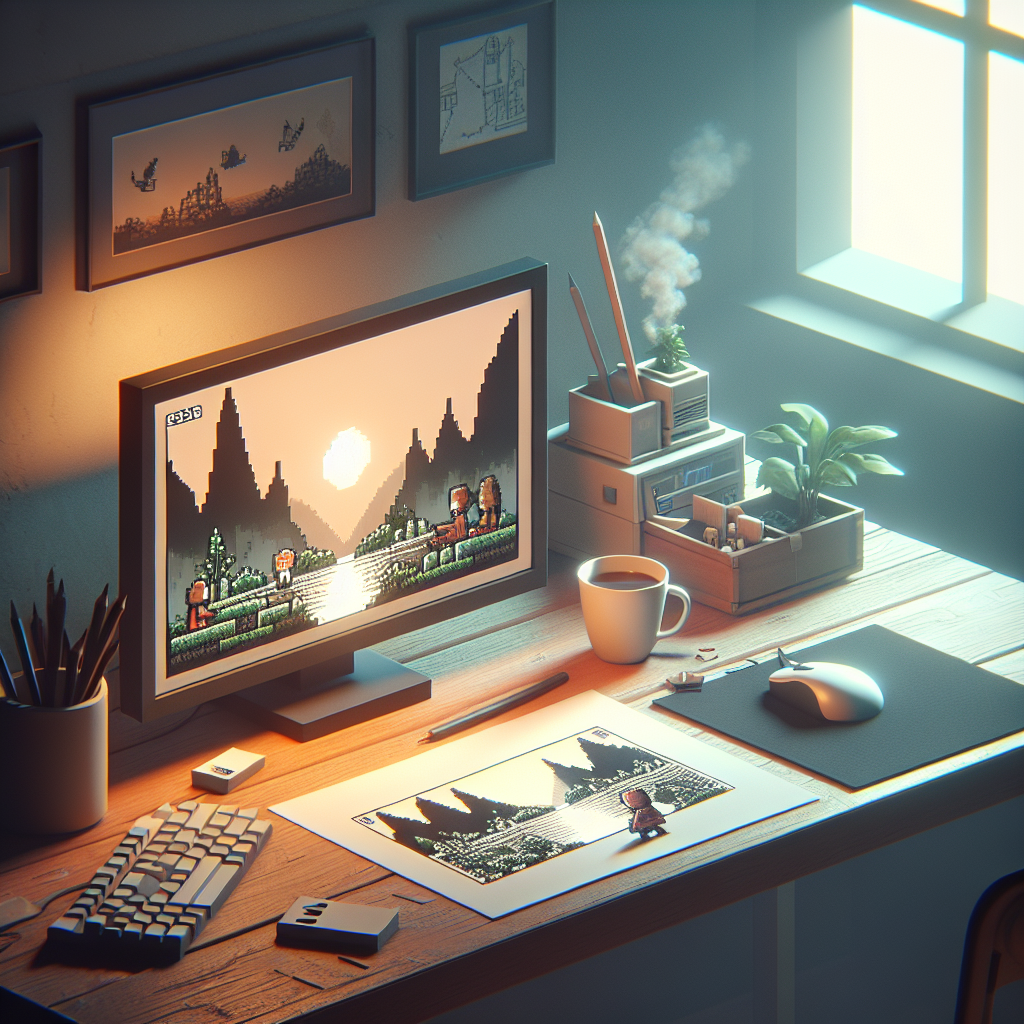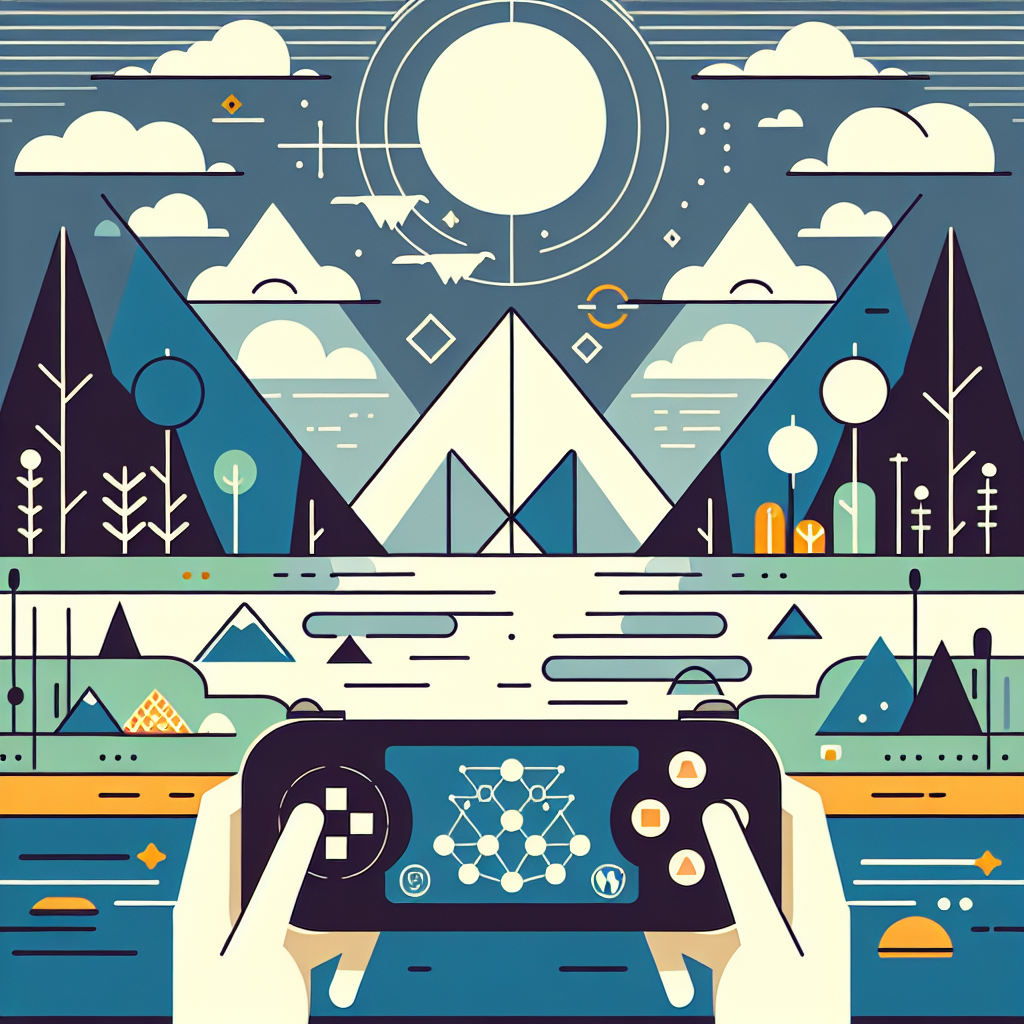In the world of gaming, there is a rising trend towards single player games with minimalist design. These games are characterized by their simple graphics, clean interfaces, and captivating gameplay. By stripping away distractions and focusing on the core mechanics, minimalist games offer players a unique and immersive experience. From puzzle-solving adventures to narrative-driven journeys, these games challenge players to think creatively and engage with the game world in a more meaningful way. Join us as we delve into the allure of single player games with minimalist design and discover the beauty of simplicity in gaming.
Understanding Minimalist Design in Single Player Games

Minimalist design in single player games refers to the intentional simplification and reduction of elements within the game to focus on essential gameplay aspects. This design approach emphasizes clarity, elegance, and efficiency in delivering a captivating gaming experience to players.
Defining minimalist design in gaming
Minimalist design in gaming involves stripping away unnecessary features, distractions, and complexities that do not contribute directly to the core gameplay. It aims to create a streamlined and immersive gaming experience by emphasizing quality over quantity. This design philosophy often involves clean visuals, simple mechanics, and a strong focus on player engagement.
Characteristics of minimalist game design
- Simplicity: Minimalist games have straightforward mechanics and visuals that are easy to understand and navigate.
- Elegance: The design is characterized by a sense of refinement and sophistication achieved through careful selection and presentation of game elements.
- Focus on Core Gameplay: Minimalist games prioritize the core gameplay loop, ensuring that every element serves a specific purpose in enhancing the player experience.
- Emotional Impact: Despite the minimalist approach, these games can evoke powerful emotions and create meaningful connections with players through subtle storytelling and immersive gameplay.
Importance of minimalist design in single player games
Minimalist design plays a crucial role in single player games by offering a more focused and immersive gaming experience. By eliminating clutter and distractions, minimalist games allow players to fully engage with the game world, mechanics, and narrative. This design approach also encourages creativity and innovation, challenging developers to convey depth and complexity through simplicity. Ultimately, minimalist design in single player games enhances player satisfaction, promotes deeper immersion, and highlights the artistry of game development.

Evolution of Single Player Games with Minimalist Design
Early minimalist games
volution of Single Player Games with Minimalist Design
Pioneering minimalist games
In the early days of gaming, minimalist design was a novel concept that challenged the industry’s prevailing focus on flashy graphics and complex gameplay. Games like “Tetris” and “Pong” are considered pioneers of minimalist design, featuring simple graphics, basic mechanics, and a focus on core gameplay elements. These games proved that a game didn’t need elaborate visuals or intricate storylines to captivate players; instead, they highlighted the importance of gameplay and mechanics in creating an engaging experience.
Influence on modern game development
The influence of early minimalist games on modern game development cannot be overstated. Developers today look to these pioneering titles for inspiration, recognizing the power of simplicity in creating immersive gaming experiences. The success of games like “Minecraft” and “Limbo” further solidifies the impact of minimalist design, showcasing how a stripped-down aesthetic can enhance gameplay and evoke emotional responses from players. By focusing on core mechanics and player engagement, minimalist games continue to shape the industry and attract a dedicated fan base seeking meaningful gaming experiences.
Contemporary minimalist games
In the realm of contemporary gaming, single player games with minimalist design have carved a niche for themselves, captivating players with their simplicity and elegance. These games prioritize clean aesthetics, intuitive gameplay, and immersive storytelling over flashy graphics and complex mechanics, offering a refreshing and engaging experience for those seeking a more contemplative gaming journey.
Popular single player games with minimalist design
-
“Journey”: This critically acclaimed game takes players on a visually stunning odyssey through a mysterious desert, where they interact with other players in a wordless and ethereal adventure. With its minimalist art style and evocative soundtrack, “Journey” immerses players in a profound emotional journey that resonates long after the game is completed.
-
“Limbo”: Known for its haunting monochromatic visuals and ambient sound design, “Limbo” is a puzzle-platformer that challenges players to navigate a treacherous world filled with traps and enigmas. With minimal dialogue and a stark aesthetic, “Limbo” creates a sense of foreboding and intrigue that keeps players on edge throughout the game.
Unique features and gameplay elements
-
Environmental storytelling: Many minimalist games rely on subtle environmental cues and minimalistic visuals to convey narrative depth and emotional resonance. By eschewing overt exposition and dialogue, these games encourage players to interpret and engage with the game world on a more personal and introspective level.
-
Simplified mechanics: Minimalist games often feature streamlined mechanics that prioritize player experience and immersion. By removing extraneous elements and focusing on core gameplay loops, these games offer a sense of purity and clarity that enhances the overall gaming experience.

In conclusion, contemporary single player games with minimalist design offer a compelling alternative to mainstream titles, inviting players to explore new worlds and narratives through the lens of simplicity and elegance.
Impact of Minimalist Design on Player Experience
Immersive gameplay
ct of Minimalist Design on Player Experience
Minimalist design in single-player games plays a pivotal role in enhancing player immersion by stripping away unnecessary distractions and focusing on essential gameplay elements. This deliberate simplification allows players to fully engage with the game world and storyline without being overwhelmed by excessive visual stimuli or convoluted mechanics.
How minimalist design enhances player immersion:
-
By removing extraneous details, minimalist design directs the player’s attention to key aspects of the game, such as narrative progression, strategic decision-making, and character development. This focused experience creates a sense of flow, where players become deeply absorbed in the gameplay without external interruptions.
-
The use of clean visuals, intuitive controls, and uncluttered interfaces in minimalist games fosters a seamless interaction between the player and the digital environment. This seamless integration promotes a sense of presence and agency, allowing players to feel like an active participant in shaping the game’s outcome.
-
Minimalist design often prioritizes atmospheric elements, such as ambient soundscapes, subtle animations, and minimalist soundtracks, to evoke mood and emotion. By immersing players in a carefully crafted audio-visual experience, minimalist games can evoke a wide range of feelings, from tranquility and introspection to tension and excitement.
Fostering emotional connection through simplicity:
-
The simplicity of minimalist design can evoke powerful emotional responses from players by emphasizing the core themes and emotions embedded in the game’s narrative. Without the distraction of complex visuals or convoluted gameplay mechanics, players can more easily empathize with characters, relate to story arcs, and reflect on the underlying messages conveyed through gameplay.
-
Minimalist games often rely on symbolism, metaphor, and understated storytelling techniques to convey deep emotional resonance without explicitly stating every detail. This ambiguity invites players to interpret and engage with the game on a personal level, fostering a sense of emotional investment and attachment to the virtual world they inhabit.
-
Through the use of minimalist design principles, single-player games can create a profound and lasting impact on players by prioritizing meaningful interactions, immersive storytelling, and emotional depth over superficial aesthetics or technical complexity. By embracing simplicity as a powerful tool for player engagement, minimalist games offer a unique and compelling gaming experience that resonates on both intellectual and emotional levels.
Engaging storytelling
Utilizing minimalist design for storytelling in single player games can be a powerful tool in captivating players’ attention and emotions. By stripping away unnecessary elements and focusing on essential details, game developers can create a more immersive and impactful narrative experience for the player.
Creating a sense of mystery: Minimalist design often leaves room for interpretation, allowing players to fill in the gaps with their imagination. This can lead to a more engaging and thought-provoking storytelling experience as players piece together the narrative through subtle clues and hints.
Emphasizing character development: With minimalist design, game developers can highlight the depth and complexity of characters through their actions and dialogue rather than relying on elaborate backstories or excessive exposition. This can create more nuanced and relatable characters that resonate with players on a deeper level.
Focusing on emotional impact: By stripping away distractions, minimalist design allows for a more focused exploration of themes and emotions within the game’s story. This can lead to more powerful and poignant storytelling moments that evoke genuine emotional responses from players.
In conclusion, engaging storytelling in single player games with minimalist design can elevate the player experience by fostering a deeper connection to the narrative, characters, and themes presented in the game.
Challenges and Opportunities in Developing Minimalist Single Player Games
Design considerations
Considerations
- Balancing simplicity with engaging gameplay
In minimalist single player games, the challenge lies in striking a delicate balance between simplicity and depth of gameplay. The design must ensure that the game mechanics are straightforward and easy to grasp, while still providing enough complexity to keep players engaged over time. Achieving this balance often involves meticulous playtesting and iteration to refine the gameplay experience without compromising the minimalist aesthetic.
- Leveraging minimalism for innovative game mechanics
Minimalist design can serve as a fertile ground for innovation in game mechanics. By stripping away extraneous elements, developers are forced to focus on core gameplay mechanics, leading to the discovery of unique and unconventional ways to interact with the game world. Leveraging minimalism in this way can result in games that offer fresh and compelling experiences for players, setting them apart in a crowded market dominated by more complex and visually cluttered titles.
Artistic expression
Challenges and Opportunities in Developing Minimalist Single Player Games
In the realm of minimalist single player games, developers often view design choices through the lens of artistic expression, utilizing simplicity to convey deeper meanings and evoke emotions. This approach allows for a focus on essential elements, stripping away distractions to create a more immersive experience for players. By embracing minimalist design, game creators have the opportunity to explore the intersection of gameplay and visual storytelling, pushing the boundaries of traditional game artistry.
-
Using minimalist design as a form of artistic expression
Minimalist design in single player games serves as a canvas for artistic expression, where every element is carefully curated to communicate a specific mood or theme. Through the strategic use of color palettes, shapes, and negative space, developers can evoke a wide range of emotions and convey complex narratives without relying on elaborate graphics or intricate details. This minimalist approach challenges designers to distill their creative vision to its purest form, encouraging innovation and experimentation in the realm of game development. -
Pushing boundaries of visual storytelling in gaming
The minimalist design philosophy in single player games opens up new possibilities for visual storytelling, encouraging developers to think outside the conventional gaming aesthetics. By simplifying visuals and focusing on the essence of the narrative, game creators can engage players on a deeper level, prompting them to interpret and engage with the game world in a more profound way. This emphasis on visual storytelling not only enhances the player experience but also showcases the power of minimalist design in conveying complex themes and emotions within a game environment.
Critically Acclaimed Single Player Games with Minimalist Design
Game analysis
Case studies of successful minimalist games
- Monument Valley: This critically acclaimed puzzle game by ustwo Games captivated players with its visually stunning minimalist design, simple gameplay mechanics, and immersive storytelling. It received praise for its elegant art style, clever level design, and soothing soundtrack, proving that a minimalist approach can create a memorable gaming experience.
- Limbo: Playdead’s atmospheric platformer, Limbo, is another example of a successful minimalist game that resonated with players worldwide. With its monochromatic visuals, ambient sound design, and challenging puzzles, Limbo showcased how stripping away unnecessary elements can enhance the overall gameplay and evoke a sense of mystery and intrigue.
Critically acclaimed titles and their impact on the gaming industry
- Journey: Thatgamecompany’s Journey is a prime example of a single-player game with minimalist design that left a lasting impact on the gaming industry. Through its wordless narrative, breathtaking visuals, and innovative multiplayer mechanics, Journey demonstrated how simplicity and elegance can create a profound emotional experience for players. Its success paved the way for more artistic and introspective games in the industry.
- Celeste: Matt Makes Games’ Celeste is a modern indie darling that showcases the power of minimalist design in a challenging platformer. With its tight controls, pixel art style, and heartfelt story about mental health, Celeste garnered critical acclaim and resonated with players for its emotional depth and accessibility. It proved that even in a genre known for its complexity, a minimalist approach can deliver a compelling and meaningful gaming experience.
Player reception
Critically Acclaimed Single Player Games with Minimalist Design
- Understanding player reactions to minimalist game design
Players often appreciate minimalist design in single player games for its ability to convey a sense of clarity and focus. By stripping away extraneous elements and emphasizing simplicity, players are able to immerse themselves more fully in the core gameplay experience. This intentional design choice allows for a more streamlined and cohesive interaction between the player and the game world. The absence of clutter and unnecessary distractions can enhance the player’s engagement and concentration, leading to a more satisfying and impactful gaming experience.
- Exploring the appeal of minimalist single player games
The appeal of minimalist single player games lies in their ability to evoke a sense of elegance and sophistication through simplicity. Players are drawn to the clean aesthetics and uncluttered interfaces that minimalist design offers, as it creates a visually pleasing and harmonious experience. The focus on essential gameplay mechanics and mechanics can also lead to a more intuitive and accessible gaming experience, allowing players to easily grasp the core concepts and mechanics without feeling overwhelmed. Additionally, minimalist design can evoke a sense of tranquility and mindfulness, creating a meditative and immersive atmosphere that encourages players to fully engage with the game world.
The Future of Single Player Games with Minimalist Design
- Trends in minimalist game development
In recent years, there has been a noticeable shift towards minimalist design in single player games. This trend is characterized by a focus on simplicity, elegance, and clarity in game mechanics, visuals, and storytelling. Developers are increasingly embracing the idea that less can be more, creating games that prioritize a clean aesthetic and streamlined gameplay experience over flashy graphics and complex narratives. This trend can be seen across various genres, from indie titles to AAA releases, indicating a growing appreciation for the beauty and effectiveness of minimalist design in engaging players on a deeper level.
- Potential for growth and innovation in minimalist single player games
As the popularity of minimalist single player games continues to rise, there is significant potential for growth and innovation in this space. By stripping away unnecessary elements and focusing on core gameplay mechanics, developers can explore new ways to captivate players and deliver compelling gaming experiences. The simplicity of minimalist design allows for greater accessibility and broad appeal, attracting both casual and hardcore gamers alike. With advancements in technology enabling more creative expression and experimentation, the future of single player games with minimalist design looks promising, offering opportunities for fresh ideas, unique storytelling approaches, and immersive gameplay that resonates with players on a profound level.
FAQs for Exploring the Allure of Single Player Games with Minimalist Design
What are single player games with minimalist design?
Single player games with minimalist design are video games that prioritize simplicity, clean aesthetics, and intuitive gameplay mechanics over elaborate graphics and complex storytelling. These games often feature a stripped-down visual style, with a focus on geometric shapes, bold colors, and a minimalist user interface.
What makes single player games with minimalist design appealing?
The appeal of single player games with minimalist design lies in their ability to offer a soothing and immersive experience. By eliminating distractions and focusing on essential gameplay elements, these games allow players to fully engage with the core mechanics and challenges. The minimalist design also creates a sense of elegance and purity, which can be both aesthetically pleasing and mentally stimulating.
Are single player games with minimalist design suitable for all types of gamers?
While single player games with minimalist design may not appeal to every gamer, they can be enjoyed by a wide range of players. The simplicity and accessibility of these games make them particularly attractive to casual gamers or those looking for a relaxing gaming experience. However, hardcore gamers can also appreciate the strategic depth and challenging gameplay that many minimalist games offer.
What are some examples of popular single player games with minimalist design?
Some popular single player games with minimalist design include titles such as “Monument Valley,” “Limbo,” “Journey,” and “Inside.” These games have received critical acclaim for their innovative gameplay mechanics, captivating visual style, and immersive storytelling. Each of these titles demonstrates the unique and engaging experiences that minimalist design can bring to the world of gaming.
